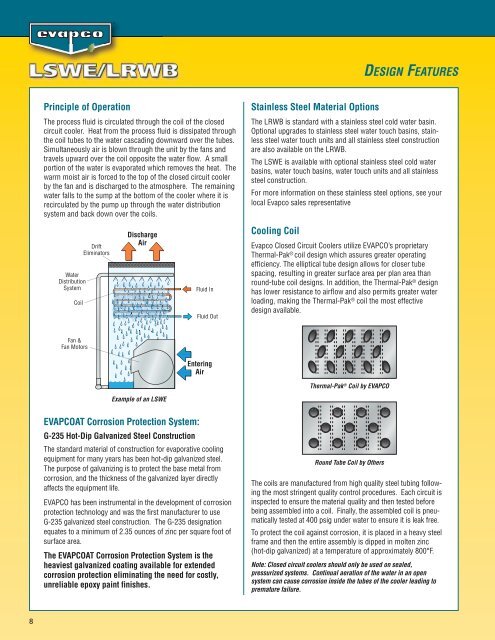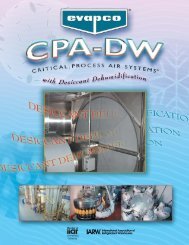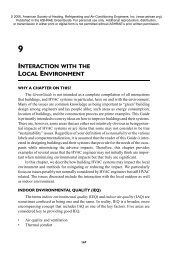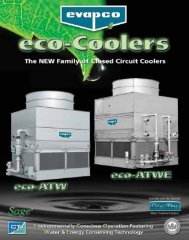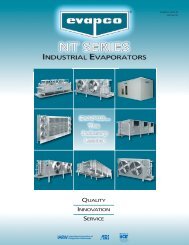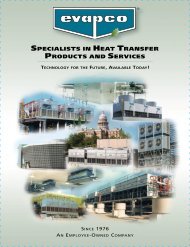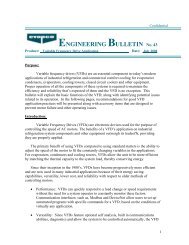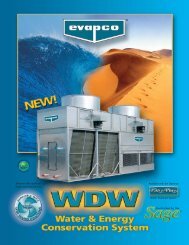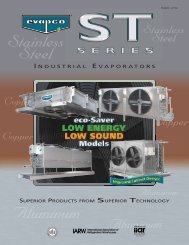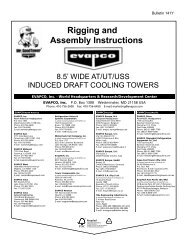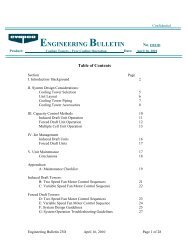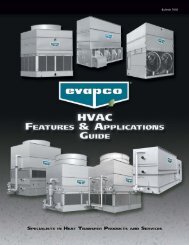LSWE Product Catalog - EVAPCO.com
LSWE Product Catalog - EVAPCO.com
LSWE Product Catalog - EVAPCO.com
Create successful ePaper yourself
Turn your PDF publications into a flip-book with our unique Google optimized e-Paper software.
8<br />
Principle of Operation<br />
The process fluid is circulated through the coil of the closed<br />
circuit cooler. Heat from the process fluid is dissipated through<br />
the coil tubes to the water cascading downward over the tubes.<br />
Simultaneously air is blown through the unit by the fans and<br />
travels upward over the coil opposite the water flow. A small<br />
portion of the water is evaporated which removes the heat. The<br />
warm moist air is forced to the top of the closed circuit cooler<br />
by the fan and is discharged to the atmosphere. The remaining<br />
water falls to the sump at the bottom of the cooler where it is<br />
recirculated by the pump up through the water distribution<br />
system and back down over the coils.<br />
Water<br />
Distribution<br />
System<br />
Coil<br />
Fan &<br />
Fan Motors<br />
Drift<br />
Eliminators<br />
Discharge<br />
Air<br />
Example of an <strong>LSWE</strong><br />
<strong>EVAPCO</strong>AT Corrosion Protection System:<br />
G-235 Hot-Dip Galvanized Steel Construction<br />
Fluid In<br />
Fluid Out<br />
Entering<br />
Air<br />
The standard material of construction for evaporative cooling<br />
equipment for many years has been hot-dip galvanized steel.<br />
The purpose of galvanizing is to protect the base metal from<br />
corrosion, and the thickness of the galvanized layer directly<br />
affects the equipment life.<br />
<strong>EVAPCO</strong> has been instrumental in the development of corrosion<br />
protection technology and was the first manufacturer to use<br />
G-235 galvanized steel construction. The G-235 designation<br />
equates to a minimum of 2.35 ounces of zinc per square foot of<br />
surface area.<br />
The <strong>EVAPCO</strong>AT Corrosion Protection System is the<br />
heaviest galvanized coating available for extended<br />
corrosion protection eliminating the need for costly,<br />
unreliable epoxy paint finishes.<br />
Stainless Steel Material Options<br />
The LRWB is standard with a stainless steel cold water basin.<br />
Optional upgrades to stainless steel water touch basins, stainless<br />
steel water touch units and all stainless steel construction<br />
are also available on the LRWB.<br />
The <strong>LSWE</strong> is available with optional stainless steel cold water<br />
basins, water touch basins, water touch units and all stainless<br />
steel construction.<br />
For more information on these stainless steel options, see your<br />
local Evapco sales representative<br />
Cooling Coil<br />
Evapco Closed Circuit Coolers utilize <strong>EVAPCO</strong>’s proprietary<br />
Thermal-Pak ® coil design which assures greater operating<br />
efficiency. The elliptical tube design allows for closer tube<br />
spacing, resulting in greater surface area per plan area than<br />
round-tube coil designs. In addition, the Thermal-Pak ® design<br />
has lower resistance to airflow and also permits greater water<br />
loading, making the Thermal-Pak ® coil the most effective<br />
design available.<br />
Thermal-Pak ® Coil by <strong>EVAPCO</strong><br />
Round Tube Coil by Others<br />
DESIGN FEATURES<br />
The coils are manufactured from high quality steel tubing following<br />
the most stringent quality control procedures. Each circuit is<br />
inspected to ensure the material quality and then tested before<br />
being assembled into a coil. Finally, the assembled coil is pneumatically<br />
tested at 400 psig under water to ensure it is leak free.<br />
To protect the coil against corrosion, it is placed in a heavy steel<br />
frame and then the entire assembly is dipped in molten zinc<br />
(hot-dip galvanized) at a temperature of approximately 800°F.<br />
Note: Closed circuit coolers should only be used on sealed,<br />
pressurized systems. Continual aeration of the water in an open<br />
system can cause corrosion inside the tubes of the cooler leading to<br />
premature failure.


